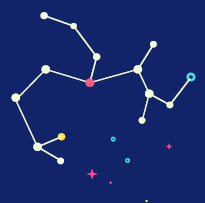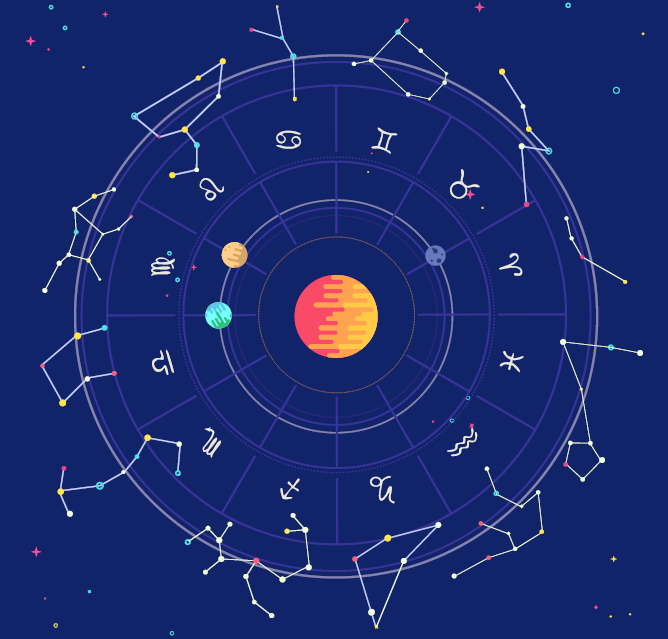
What is it about astrology that gives it such enduring appeal? Astrological predictions are a pseudoscience–they can’t be falsified. Unfortunately, the pseudoscientific aspects obscure the fact that the zodiac, the foundation upon which astrology is built, is a technically sound datum. Conceptually, it is no different than the planes, ellipsoids, and geoids that surveyors and other geospatial professionals rely on every day.
History
The zodiac has a long and complicated history. While the ancient Babylonians garner most of the credit for its invention, they may have adopted the idea from the Egyptians and refined it. The Babylonians were surprisingly advanced. In the 2nd millennium BC, while other societies were learning to count to 10, they were using a base 60 number system and keeping detailed star catalogs. With this data they could deduce the position of the stars during daytime and chart the position of the sun in relation to them. They were aware that the sun passed in front of the fixed stars and that its position among them corresponded to the time of year. This made the zodiac an ideal tool for tracking the seasons.
Planetary positions were much harder to predict, even for the mathematically astute Babylonians. From the perspective of an observer on Earth, the other planets appear to speed up, slow down, and at times, stop and change direction. It’s easy to see why they thought it was important to track them. To someone with a geocentric understanding of the cosmos, it must have appeared that the planets moved according to their own volitions. Are they gods? With the zodiac they could track their movements.
In essence, a datum is simply a geometric figure attached to the physical world. In the case of the zodiac, that figure is a cylinder. The zodiac is an 18-degree wide band of sky encircling the earth. Often it is likened to a wheel with 12 spokes. Traditionally it is a geocentric datum with the earth sitting at the hub but it is often shown from a heliocentric perspective. It works either way. The centerline of the 18-degree wide wheel track is aligned to the ecliptic, the apparent path of the sun.
The 30-degree sectors between neighboring spokes correspond to the 12 signs of the zodiac. Beginning with Aries, they are arranged counterclockwise in the same order as listed in the newspaper horoscopes.
This is the geometric figure but a geometric figure, in and of itself, does not constitute a datum. Until it is tied to the real world, until it is realized, it’s just an idea floating around in an imaginary world.
The realization of the zodiac is based on angular measurements to certain points in the sky. The stars, the ecliptic, and the vernal equinox all play a part in this.
Precession of the Equinox
Tying a datum to the physical world is necessary, but it comes at a cost. Over time, survey datums degrade because the monuments that they are tied to move. This is due to plate tectonics, local subsidence, and other factors. And it’s not a question of if–it’s a matter of when. This is a fundamental property of datums and astrological datums are no exception. The largest movement affecting the zodiac is due to an effect known as the precession of the equinox.
The vernal (spring) equinox is related to the earth’s orbital position. It occurs at a point in space and time in which the pole of the earth is tilted perpendicular to the sun.
Here’s the rub: That position changes slowly over time. The reason? We live in an imperfect world.
It wobbles.
From the vantage of a spaceman floating above the earth and looking down at the north pole, the earth spins on its axis in the same direction as it orbits the sun: counterclockwise. While doing this, the tip of the North Pole wanders clockwise. Over a 26,000 year cycle it traces a full circle. Due to the changing tilt of the axis, the orbital position of the earth at the moment of equinox changes. This causes the equinox to move backwards through the zodiac and the effect is called precession of the equinox.
Due to precession all four seasons walk around the sun every 26,000 years. This is the Great Year. It takes 1/12th of that, 2170 years, for the seasons to walk through one sign. These are the Great Months, or more poetically, the Ages of Man.
It’s been approximately one Great Month since the Romans appropriated the zodiac from the Greeks and kicked out their gods and enshrined it with their own. When they did this they performed a realization. They rotated the wheel and aligned the leading spoke of Aries with the vernal equinox. Since then, due to the wandering pole, the equinox has moved clockwise through Pisces and entered into the constellation of Aquarius, hence the song lyric: “We’re at the dawning of the Age of Aquarius.” (Some say it’s still in Pisces–there’s no definitive date.)
A War of Ideas
Thanks to precession, there’s a war in western astrology and the battlefield is the zodiac. The argument between the warring sides hinges on a technical point: Which is the proper realization? Is it Zodiac (tropical) or Zodiac (sidereal)?
Zodiac (tropical) The tropical realization is the dominant system in western astrology. Under this scheme, the first point of Aries is still tied to the vernal equinox. As the equinox rotates clockwise over the ages, due to precession, the zodiac remains locked to it and rotates along with it.
Here’s the problem. Using this realization, the constellations are no longer in their original signs. When you look at the vernal equinox, you are looking at the sign of Aries but you aren’t looking at the constellation of Aries–you are looking at the constellation of Aquarius. Strangely, under the tropical system none of the constellations live in their namesake signs.
Zodiac (sidereal) The sidereal astrologers, on the other hand, insist that the zodiac be tied to the constellations, not the vernal equinox. In this system the signs stay in a fixed position relative to the stars. Consequently the constellations still do live in their original signs. The result is that the equinox moves through the zodiac. One problem with the sidereal zodiac is that it’s hard to define exactly where one constellation ends and another begins, which makes the orientation of the wheel somewhat arbitrary.
Conclusion
Which is better: Zodiac (tropical) or Zodiac (sidereal)? Is it the seasons that control our fates or is it the stars? Opinions vary. Astrologers, like everyone else, can’t agree with each other. But that’s half the fun.
Today, most people take their daily horoscope with a cup of coffee and a grain of salt. The zodiac, on the other hand, is not pseudoscience and has stood the test of time. The wheel keeps on turning.
